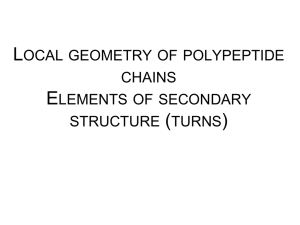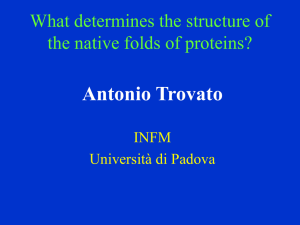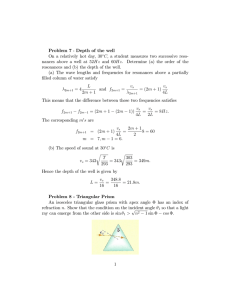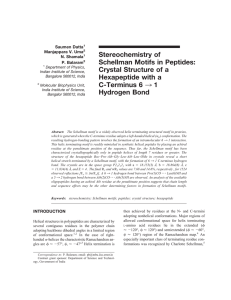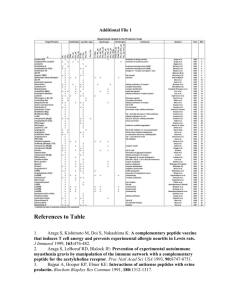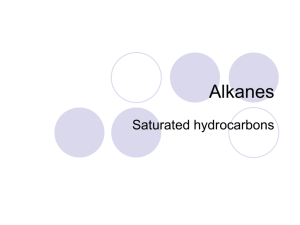b
advertisement
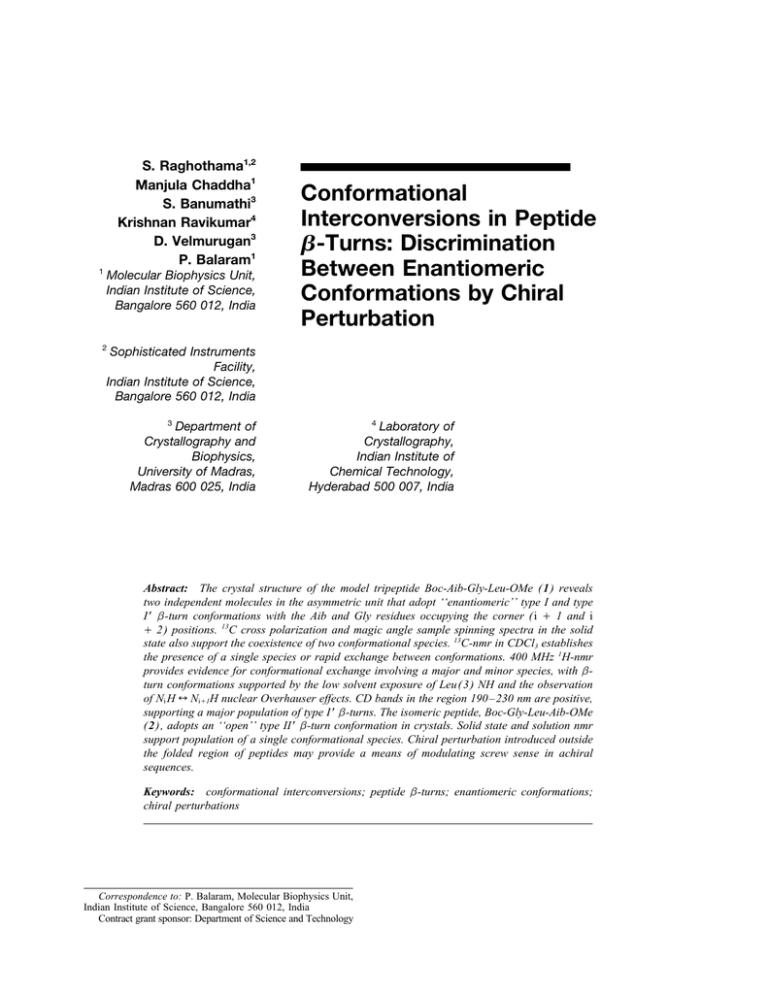
S. Raghothama1,2
Manjula Chaddha1
S. Banumathi3
Krishnan Ravikumar4
D. Velmurugan3
P. Balaram1
1
Molecular Biophysics Unit,
Indian Institute of Science,
Bangalore 560 012, India
Conformational
Interconversions in Peptide
b-Turns: Discrimination
Between Enantiomeric
Conformations by Chiral
Perturbation
2
Sophisticated Instruments
Facility,
Indian Institute of Science,
Bangalore 560 012, India
3
Department of
Crystallography and
Biophysics,
University of Madras,
Madras 600 025, India
4
Laboratory of
Crystallography,
Indian Institute of
Chemical Technology,
Hyderabad 500 007, India
Abstract: The crystal structure of the model tripeptide Boc-Aib-Gly-Leu-OMe (1) reveals
two independent molecules in the asymmetric unit that adopt ‘‘enantiomeric’’ type I and type
I * b-turn conformations with the Aib and Gly residues occupying the corner (i / 1 and i
/ 2) positions. 13C cross polarization and magic angle sample spinning spectra in the solid
state also support the coexistence of two conformational species. 13C-nmr in CDCl3 establishes
the presence of a single species or rapid exchange between conformations. 400 MHz 1H-nmr
provides evidence for conformational exchange involving a major and minor species, with bturn conformations supported by the low solvent exposure of Leu(3) NH and the observation
of Ni H } Ni/1H nuclear Overhauser effects. CD bands in the region 190–230 nm are positive,
supporting a major population of type I * b-turns. The isomeric peptide, Boc-Gly-Leu-Aib-OMe
(2), adopts an ‘‘open’’ type II * b-turn conformation in crystals. Solid state and solution nmr
support population of a single conformational species. Chiral perturbation introduced outside
the folded region of peptides may provide a means of modulating screw sense in achiral
sequences.
Keywords: conformational interconversions; peptide b-turns; enantiomeric conformations;
chiral perturbations
Correspondence to: P. Balaram, Molecular Biophysics Unit,
Indian Institute of Science, Bangalore 560 012, India
Contract grant sponsor: Department of Science and Technology
/
8K39$$5534
12-18-97 10:39:53
bpal
W: Biopolymers
INTRODUCTION
b-Turns are widely distributed and extensively
characterized structural elements in peptides and
proteins.1 – 3 Peptide models for b-turns have attracted current interest in view of their importance
in understanding fundamental features of peptide
conformation 4 – 10 and in designing conformationally
defined analogues of biologically active peptides.11,12 The stereochemical features of b-turns are
determined by the backbone conformational angles
( f, c ) at residues (i / 1) and (i / 2), which
occupy the corner positions in tight turns.13 – 15 Conformational interconversions between various bturn types are possible in solution. Indeed, interconversion between b-turn types have been inferred
from nmr studies of HIV protease.16 In small peptides, the relatively low barrier to rotation about the
N{C a ( f ) and C a{CO ( c ) bonds 17 makes such
interconversions kinetically feasible. In most peptides, the presence of chiral residues results in a
strong preference for one set of b-turns with large
energy differences often precluding significant population of alternative structures.
In order to investigate conformational interconversions in peptides, we have chosen to examine
the model tripeptide Boc-Aib-Gly-Leu-OMe (1). In
this sequence, b-turn formation is facilitated by the
stereochemical constraints imposed by the a-aminoisobutyric acid (Aib) residue. Since Aib has a very
strong tendency to adopt f,c values 18 that lie in the
right- or left-handed helical region of f,c space,
either type I/III or type I * /III * conformations are
likely to be favored.19,20 The Gly residue at position
2 also has a high b-turn propensity. Thus, the AibGly segment that is achiral favors either type I/
III or the enantiomeric type I * /III * conformations.
These mirror image b-turn conformations (Figure
1) are isoenergetic in achiral sequences. The induction of a chiral residue L-Leu at position 3 makes
the two types of conformations diastereomeric and
thus energetically nonequivalent, in principle, and
also provides a handle for spectroscopic distinction.
Since the chiral center is placed outside the central
positions of the b-turn, it may be expected that both
conformational types may be present in appreciable
populations. In this article we establish the coexistence of the two enantiomeric b-turns in single crystals by x-ray diffraction and in the solid state by 13Cnmr cross-polarization magic angle sample spinning
(CPMAS) spectroscopy. In solution, evidence for
conformational interconversion is presented using
variable temperature 1H-nmr.
In the isomeric peptide Boc-Gly-Leu-Aib-OMe
(2), which contains a chiral residue at position (i
/ 2) of a putative b-turn, only a single conformation is observed in the solid state with no evidence
for slow dynamic interconversion on the nmr time
scale in solution.
EXPERIMENTAL
Peptide Synthesis
Peptides 1 and 2 were synthesized by conventional solution phase procedures and purified by medium pressure
liquid chromatography on a reverse phase column. The
peptides were obtained as a white crystalline solids, ho-
FIGURE 1 Equilibration of idealized type I/III and I * /III * b-turn conformations in 1. The
interconversion involves rotations about fi /1 , ci /1 and fi /2 , ci /2 , where Aib and Gly are the
i / 1 and i / 2, residues. Hydrogen atoms and Leu(3) C g and C d atoms are omitted for
clarity. The ideal conformational f,c angles at the (i / 1) and (i / 2) position of various
types of b-turns are as follows: Type I: 0607, 0307; 0907, 07. Type I *: 607, 307; 907, 07. Type
II: 0607, 1207; 807, 07. Type II *: 607, 01207; 0807, 07. Type III: 0607, 0307; 0607, 0307.
Type III *: 607, 307; 607, 307. Note that type I(I * ) and III(III * ) turns differ only marginally in
their fi /2 / ci /2 values. For purposes of discussion in this paper, no distinction is made between
these two turn types.
8K34
/
8K39$$5534
12-18-97 10:39:53
bpal
W: Biopolymers
5534
Table I
Crystal Parameters
Experimental Data
Boc-Aib-Gly-Leu-OMe (1)
Empirical formula
Molecular weight
Crystal system
Crystal size (mm)
Crystallizing solvent
Space group
Cell parameters
a (Å)
b (Å)
c (Å)
a (deg)
b (deg)
g (deg)
Volume (Å3)
Z
Molecules/asym. unit
Cocrystallized solvent
Density (g/cm3; cal)
F(000)
Radiation (Å)
Temperature (7C)
2u Range (7)
Scan type
Independent reflections
Observed reflections
R value
Rw value
Data to parameter ratio
C18H33N3O6
387.5
Monoclinic
0.2 1 0.2 1 0.4
DMSO
P21
C18H33N3O6
387.5
Orthorhombic
0.2 1 0.2 1 0.4
DMSO
P212121
13.15 (2)
9.64 (1)
17.57 (2)
90.0
96.3 (1)
90.0
2212.4 (4)
4
2
None
1.16
840
MoKa (l Å 0.7107)
25
45
v 0 2u
3102 [I ú 3s (I)]
2126
5.7%
5.6%
4:1
5.802 (1)
18.116 (1)
21.996 (3)
90.0
90.0
90.0
2311.9 (5)
4
1
None
1.11
840
MoKa
25
45
v 0 2u
1803 [I ú 3s (I)]
1032
5.6%
6.1%
4:1
mogeneous by analytical high performance liquid chromatography on a C18-5m column. The peptides were
characterized by complete assignment of their 400 MHz
1
H-nmr spectra.
X-Ray Crystallography
Crystals of both peptides were grown from DMSO solution by slow evaporation. The x-ray diffraction data were
collected on a Siemens from R3m/V diffractometer with
MoKa radiation. Refined unit cell parameters were determined by a least-squares fit of the angular setting of 25
accurately determined reflections in the range of 87 õ u
õ 137. Three-dimensional intensity data were collected
up to 2u Å 457 using the v 0 2u scan mode. Two standard
reflections were monitored during every 98 intensity measurements. The intensity decay was less than 1%. Parameters pertaining to the crystal data collection and refinement are listed in Table I.
The structures were solved and refined isotropically and
anisotropically using the program package SHELXTLPlus.21 Full matrix anisotropic least-squares refinement
was done on all the nonhydrogen atoms. All the hydrogens were geometrically fixed and included as riding
8K34
/
8K39$$5534
Boc-Gly-Leu-Aib-OMe (2)
12-18-97 10:39:53
atoms with fixed isotropic displacement parameters in the
structure factor calculation. The final R factors for the
structures Boc-Aib-Gly-Leu-OMe and Boc-Gly-LeuAib-OMe were 5.7 and 5.6%, respectively. The function
minimized was ( w(É F0É 0 É FcÉ) 2 , where w Å 1/
[ s 2 (F) / 0.0005(F 2 )]. The torsion angles and hydrogen
bonds in the two structures are listed in Tables II and III,
respectively.
NMR Spectroscopy
Solution nmr studies were carried out on a Bruker AMX400 spectrometer. For 1H-nmr, peptide concentrations
were approximately 15 mM. Aggregation was not observed in this peptide. Resonance assignments of backbone protons was straightforward. Two-dimensional
(2D) rotating frame nuclear Overhauser effect spectroscopy (ROESY) spectra were recorded at 298 and 223 K
in the phase-sensitive mode using the time proportional
phase incrementation method. A spin–lock time of 300
ms was used.
The 100.61 MHz 13C spectra on the same spectrometer
were recorded with proton decoupling. Concentrations
were Ç 0.2M. Resonance assignments were carried out
bpal
W: Biopolymers
5534
Table II
Torsion Anglesa (7)
Boc-Aib-Gly-Leu-OMe
Molecule A
Aib
Gly
Leu
Molecule B
Aib
Gly
Leu
Boc-Gly-Leu-Aib-OMe
Gly
Leu
Aib
f
c
v
x1
x2
067.7b
079.0
084.2
019.1
017.7
158.5c
0161.7
178.6
179.2d
073.1
056.7, 0179.9
58.1
76.5
090.0
35.4
17.5
159.3
167.4
175.4
172.2
061.3
067.8, 172.0
59.9
076.2
45.6
0151.1
026.5
0136.3
178.1
0176.6
0169.5
065.4
064.1, 169.9
a
The torsion angles for rotation about bonds of the peptide backbone (f, c, and v) and about bonds of the amino acid sidechains
(x 1, x 2) as suggested by the IUPAC-IUB Commission on Biochemical Nomenclature.18 Estimated standard deviations Ç 1.07.
b
C*(0)A-N(1)A-Ca(1)A-C*(1)A.
c
N(3)A-Ca(3)A-C*(3)A-O(4)A.
d
Ca(3)A-C*(3)A-O(4)A-C(4)A.
with the help of heteronuclear correlation with protons.
Carbonyl carbon ( úC|O) assignments were done using
the long-range correlation experiment.22
All 2D data sets were zero filled to yield a 1K 1 1K
matrix. A shifted square sine bell window was applied
before Fourier transformation.
The 75.47 MHz solid state proton decoupled 13C spectra were recorded on Bruker DSX-300 spectrometer em-
Table III
ploying CPMAS. The samples were packed in a 4 mm
rotor and spun at Ç 6 KHz. A contact time of 1 ms
was applied for cross-polarization. Two hundred forty
transients with a relaxation delay of 5 s were accumulated
with 2K data points. Spectral widths were in the range
of 25,000 Hz.
In an attempt to observe conformations similar to that
determined in crystals, 1H-nmr spectra were recorded im-
Hydrogen Bonds
Length (Å)
Intramolecular
Boc-Aib-Gly-Leu-OMe
Molecule A 4 r 1
Molecule B 4 r 1
Boc-Gly-Leu-Aib-OMe
4r1
Intermolecular
Boc-Aib-Gly-Leu-OMe
Molecule A
Molecule B
Boc-Gly-Leu-Aib-OMe
a
Symmetry
Symmetry
c
Symmetry
d
Symmetry
b
8K34
equivalent
equivalent
equivalent
equivalent
/
Donor
Acceptor
N {O
H{ O
Angle (7)
N(3)
N(3)
O*(0)
O*(0)
3.045
3.100
2.170
2.250
164.5
158.5
N(3)
O*(0)
3.661
3.061
125.9
N(1)a
N(2)a
N(1)b
N(2)b
N(1)c
N(2)d
O*(2)
O*(1)
O*(2)
O*(1)
O*(1)
O*(2)
3.188
2.779
3.377
2.817
2.894
2.924
2.298
2.032
2.503
2.054
1.997
2.028
169.9
139.5
164.2
141.8
174.0
174.0
0x 0 1, /y / 1/2, 0z 0 1 to coordinates listed in Table S1 (Supplementary material).
0x 0 1, y 0 1/2, 0z 0 2.
x 0 1/2, 0y 0 1/2, 0z 0 1.
x 0 1, /y, /z.
8K39$$5534
12-18-97 10:39:53
bpal
W: Biopolymers
5534
FIGURE 3 A view of the packing of b-turn peptides
in crystal of 1. View down the axis.
FIGURE 2 The two b-turn conformations observed in
the crystal structure of 1, molecule A, type I/III; molecule
B, type I * /III *.
mediately after dissolution of peptide 1 crystals at 223
K. For this, the probe and the nmr sample tube containing
only CDCl3 solvent were precooled at 223 K and equilibrated for about 30 min. Then, 2–3 crystals of peptide 1
were dropped to the precooled nmr tube containing
CDCl3 . 1H-nmr recording was started immediately and a
series of spectra were collected at 90 s intervals with only
8 transients per recording.
molecules A and B adopt b-turn conformations stabilized by a single 4 r 1 intramolecular hydrogen
bond between the Boc CO and Leu(3) NH groups.
Inspection of the conformational angles in Table II
reveals that the two molecules adopt mirror image
b-turn conformations, with molecule A being designated as a type I/III b-turn while molecule B is a
type I * /III * turn. Note that the fi /2 , ci /2 values at
Gly lie between the values expected for ideal type
I or type III turns. The details of the observed intraand intermolecular hydrogen bonds are summarized
in Table III. Molecules are packed in the crystal
such that columns of one type of b-turn are firmly
held together by hydrogen bonds involving the central peptide unit between Aib(1) and Gly(2) (Figure 3).
The crystal structure of the isomeric tripeptide
Boc-Gly-Leu-Aib-OMe (2; Figure 4) reveals a type
Circular Dichroism
CD spectra were recorded on a JASCO J-750 spectropolarimeter at ambient temperature (298 K). Path length
cells of 0.2 and 1 mm were used. Scan speed was kept
at 10 nm per min and time constant at 8 s. The baseline
was obtained under similar conditions.
RESULTS AND DISCUSSION
Conformation in Single Crystals
The crystals of the peptide Boc-Aib-Gly-Leu-OMe
(1) contain two molecules in the asymmetric unit
whose conformations are shown in Figure 2. Both
8K34
/
8K39$$5534
12-18-97 10:39:53
FIGURE 4
of 2.
bpal
Type II * b-turn conformation in crystals
W: Biopolymers
5534
FIGURE 5 13C-nmr spectra of 1. (top) Proton decoupled 100.61 MHz spectrum in CDCl3
(bottom). The 75.47 MHz solid state CPMAS spectrum demonstrating doubling of resonances.
Arrows indicate the Leu(3) CO and Boc C (quaternary) carbon resonances.
II * b-turn conformation with Gly(1) and Leu(2)
at the (i / 1) and (i / 2) positions. The observed
NrrrO distance between BocrCO and Aib(3) NH
is nearly 3.6 Å, which is significantly longer than
that observed in classical b-turn conformations,
which usually lie between 2.8 and 3.2 Å.13 – 15 A
b-turn conformation has been observed earlier in
crystals of the closely related sequence Boc-GlyAla-Aib-OMe, 23 which also has the Aib residue at
a terminal position outside the turn segment.
Solution and Solid State
13
C-NMR
13
C spectra of peptide 1 in the solid state (75.47
MHz) and in CDCl3 solution (100.61 MHz) are
shown in Figure 5. Resonance assignments in solution could be accomplished using heteronuclear correlation with the corresponding 1H resonances. Inspection of the spectrum in Figure 5 shows that only
4 carbonyl (C|O) resonances are observed in the
region 150–180 ppm. In the solid state there is
distinct doubling of the resonance at Ç 172 ppm
and marked broadening of the remaining C|O resonances. The two sharp resonances at Ç 172 ppm
may be assigned to Leu(3)CO since this is an ester
8K34
/
8K39$$5534
12-18-97 10:39:53
carbonyl. Since the other 3 carbonyl groups have a
one bond coupling interaction with the 14N nucleus,
significant broadening results. Peak doubling is also
observed in the solid state for the quaternary carbon
of the Boc protecting group ( Ç 78 ppm). The upfield region of the solid state 13C spectrum is also
significantly more complex than that observed in
solution. These observations suggest that the 13C
spectrum of the solid peptide reflects the presence
of two distinct conformations, consistent with the
crystallographic results. Dissolution results in only
a single set of 13C resonances, suggesting that only
a single species is populated or that a dynamic equilibrium is achieved between multiple species on a
time scale that is much more rapid than the nmr
time scale. Figure 6 shows the solution and solid
state 13C spectra of peptide 2. In this case only one
set of lines (see Boc. quaternary carbon at Ç 78
ppm) are observed in both cases consistent with the
characterization of a single conformation by x-ray
diffraction.
Conformational Studies in Solution
The relevant nmr parameters for backbone proton in
peptide 1 are summarized in Table IV. The delineabpal
W: Biopolymers
5534
FIGURE 6 13C-nmr spectra of Boc-Gly-Leu-Aib-OMe. (top) Proton decoupled 100.61 MHz
spectrum in CDCl3 . (bottom) The 75.47 MHz solid state CPMAS spectrum. Note absence of
resonance doubling.
tion of solvent-shielded NH groups was accomplished
using solvent dependence of NH chemical shifts in a
CDCl3 /DMSO mixture and temperature coefficient
of NH chemical shifts in DMSO. Leu(3) NH exhibits
the lowest solvent sensitivity ( Dd Å 0.44 ppm) and
the lowest temperature coefficient (2.0 ppb/K). Figure 7 shows the NH } NH region of the ROESY
spectrum of peptide 1 in CDCl3 at 223 K. While
only weak nuclear Overhauser effects (NOEs) were
detectable at room temperature, significantly more intense cross peaks were observed on lowering the temperature. The NOEs observed, U(1)NH } G(2) NH
and G(2)NH } L(3)NH, are supportive of conformations in the helical region ( f Å {607 { 307; c
Å {307 { 307 ) for both Aib and Gly residues. These
Table IV NMR Parameters for Backbone Protons
in 1 in CDCl3
Aib (1)
d NH (ppm)
d CaH (ppm)
4.93
—
JNHCaHa (Hz)
—
dd/dT b (ppb/K)
Ddc (ppm)
10.5
2.09
Gly (2)
JBX
JAX
6.89
4.20
3.74
Å 7.0 (7.8)
Å 5.2 (—)d
8.4
1.12
Leu (3)
7.38
4.51
(7.0)d
2.0
0.44
a
Coupling constants at 223 K are shown in parentheses. For
Gly (2), HA is the high field CaH proton. The geminal coupling
constant JAB for Gly (2) is 17.1 Hz.
b
dd/dT is the temperature coefficient (ppb/K) of NH chemical
shifts in DMSO.
c
Dd is the chemical shift difference (ppm) for NH protons
in CDCl3 and 47.8% DMSO/CDCl3 .
d
JAX (Gly 2) and JNHCaH Leu 3 could not be determined at
223 and 298 K, respectively due to exchange broading of the
resonances (Figure 8).
8K34
/
8K39$$5534
12-18-97 10:39:53
FIGURE 7 Partial 400 MHz ROESY spectrum of peptide 1 in CDCl3 at 223 K showing Ni H } Ni /1H connectivities.
bpal
W: Biopolymers
5534
FIGURE 8 Temperature dependence of line widths and
chemical shifts in 400 MHz 1H-nmr spectra of peptide 1 in
CDCl3 . (top) NH resonances; (bottom) C aH resonances.
observations are clearly compatible with population
of type I/I * conformations. These results suggests
that b-turn conformations are also significantly populated in CDCl3 solution.
An interesting feature of the 400 MHz 1H-nmr
spectrum of peptide 1 at ambient temperature (298
K) is the selective broadening of some of the backbone resonances. Figure 8 shows the temperature
dependence of C aH and NH resonances of the peptide in CDCl3 . At 298 K, L(3)NH is broad, whereas
the U(1) and G(2)NH resonances are quite sharp.
Upon cooling there is dramatic sharpening of
L(3)NH resonance. Sharpening of resonances is
also observed for the low field Gly C aH proton at
Ç 4.2–4.3 ppm and for the Leu C aH. Appreciable
temperature-dependent chemical shifts are also observable for the G(2) C aHA , C aHB , and L(3)C aH
protons on cooling. The resonance narrowing at low
temperature is clearly supportive of a dynamic exchange process in solution. In the slow exchange
limit, distinct resonances corresponding to the two
interconverting conformations may be observed, in
principle. In the present case only a single set of
resonances are observed, which may be assigned to
a major conformational species. If the minor species
is present to a level of less than 5%, nmr detection
under present conditions would be difficult. Conformational energy differences of even 1.5–2.0 kcal/
mole can lead to undetectable amounts of minor
conformations. These nmr results support the existence of a dynamic conformational process in solution. Extrapolation from the crystallographic and
solid state 13C-nmr results suggests that the two species involved may indeed be the type I/III and I * /
III * b-turn conformations.
Conformational transitions upon dissolution of
single crystals have been monitored in an earlier
study of peptides containing Pro-Pro sequences.24
Figure 9 show NH resonances in peptide 1 recorded
as a function of time after dissolution of crystals at
FIGURE 9 NH resonances in 400 MHz 1H-nmr spectra of peptide 1 in CDCl3 , recorded at
223 K as a function of time after dissolution of crystals in precooled solvent (see Experimental).
8K34
/
8K39$$5534
12-18-97 10:39:53
bpal
W: Biopolymers
5534
FIGURE 10 Comparison of partial ROESY spectra of peptide 1 at 298 K (top) and 223 K
(bottom). The interresidue Aib(1) and Gly(2) b, N and intraresidue Aib(1) b, N NOEs are
marked. Note the differential intensities of the interresidue b, N NOEs at 223 K.
223 K. It is observed that only one set of NH resonances is seen, suggesting that conformational
equilibration in solution is rapid even at the lowest
temperature used in this experiment. An interesting
feature is a small but measurable time-dependent
narrowing of the NH resonances of U(1) and G(2).
This may be a consequence of small changes in
solution conformer populations immediately following crystal dissolution. It may be stressed that in
the case of exchange between unequally populated
sites, line broadening may be observed even when
one of the conformation is present in almost undetectable amounts.25,26
Figure 10 shows partial ROESY spectra of peptide 1 at 223 and 298 K, which highlight the NOEs
observed between the G(2) NH proton and the two
C bH3 groups of U(1). The two Aib methyl groups
8K34
/
8K39$$5534
12-18-97 10:39:53
are diastereotopic and have chemical shifts of 1.44
and 1.50 ppm at 298 K. At both temperatures, 223
and 298 K, strong NOEs between these Aib methyl
protons and Aib NH are observed. In contrast, the
G(2) NH proton shows NOEs of approximately
equal intensity to both Aib methyl resonances at
298 K, whereas at 223 K the NOE to the high field
methyl resonance is appreciably more intense than
the NOE to the low field methyl resonance. Figure
11 summarizes the dependencies of the dbN distance
on the dihedral angle c computed using the model
Ac-Aib-NHMe. For Aib conformations in the (i
/ 1) position of type I/III or I * /III * b-turns, cAib
is approximately {307. In this region, one dbN distance is significantly shorter than the other. The
temperature dependence of the ROESY intensity in
Figure 10 suggests that freezing of conformational
bpal
W: Biopolymers
5534
interconversion results in a predominant population
of only one type of b-turn with differential dbN distances. At higher temperatures rapid averaging between two ‘‘enantiomeric’’ b-turn conformations
results in equalization of dbN NOE intensities.
Circular Dichroism
Crystallographic studies of peptide 1 establish the
presence of both type I/III and I * /III * b-turn conformations in single crystals. Solution nmr studies
provide evidence for a predominant population of
one type of b-turn, with dynamic exchange occurring between a major and minor conformational
species. In order to establish the nature of the major
species, CD studies were carried out in methanol
and a cyclohexane/dichloromethane 8:2 (v/v) mixture. Figure 12 shows the CD spectrum of peptide
1 in methanol. Similar spectra were obtained in the
cyclohexane–dichloromethane system. The spectrum of peptide 2, which adopt a type II * b-turn in
the solid state, is also shown for comparison. Peptide 1 shows positive CD bands in the region below
220 nm in both solvent systems. The presence of a
positive band at 220 nm (shoulder) and at 198 nm
is consistent with a type I * /III * b-turn conformation.27 – 30 It may be noted that the enantiomeric type
I/III b-turns yield negative CD bands in this region.
The CD spectrum of peptide 2 shows two negative
bands at 228 and 200 nm. The CD studies thus
suggest that the major conformation present in solution in peptide 1 is a type I * /III * b-turn.
CONCLUSION
FIGURE 11 Dependence of the C bi H3 } Ni /1H distances computed as a function of the C a{CO torsion
angle c, in an idealized model of Ac-Aib-NHMe.
The studies presented here establish that the introduction of a chiral center adjacent to a b-turn composed of two achiral residues permits spectroscopic
detection of conformational interconversion between ‘‘enantiomeric’’ turn structures. These interconversions are characterized by low barriers as evidenced by dynamic averaging at moderate temperatures. In crystals, two conformational diastereomers
are characterized in the asymmetric unit. The presence of diastereomeric conformations in equal proportions in the solid state is also confirmed by solid
state 13C-nmr studies. In the isomeric peptide BocGly-Leu-Aib-OMe only one conformational state is
detected in the solid state by crystallography and
nmr. There is also no evidence for a conformational
exchange process in solution. It is clear that the
positioning of a chiral residue at the (i / 2) position
of a b-turn forces adoption of a type II * structure.
Interconversion between enantiomeric helical conformations have been suggested in the decapeptide
Z-(Aib)10-OtBu. Using the temperature dependence
of the 13C resonances of the C b atoms of the Aib
8K34
/
8K39$$5534
12-18-97 10:39:53
FIGURE 12
bpal
CD spectra of 1 and 2 in methanol.
W: Biopolymers
5534
residues, estimated activation barriers are on the
order of DG x Å Ç 11 kcal/mol. This enantiotopomerization has been described as a fast ‘‘monomolecular all-or-nothing’’ process between enantiomeric
helical forms.31 Since similar correlated bond rotations may be envisaged for the type I/III to type
I * /III * b-turn interconversions, the kinetic barriers
in the present case are also likely to be less than
11 kcal/mol, which is consistent with the observed
exchange effects in high resolution 1H-nmr spectra.
Crystal structure determinations provide a definitive
means of characterizing the nature of multiple conformations in the solid state. Achiral peptides almost invariably crystallize in centrosymmetric
space groups with inversion symmetry relating molecules adopting enantiomeric conformations. When
minor chiral perturbations are introduced, conformations with both screw senses, which are rendered
diastereomeric, have indeed been observed in the
crystallographic asymmetric unit. The chiral pentapeptide Ac-(Aib)2-S-Iva-(Aib)2-OMe crystallizes
in the space group P1 with both right- and lefthanded helical molecules present in the asymmetric
unit.32 In this case the chiral perturbation is extremely subtle, with the isovaline residue possessing
methyl and ethyl substituents at the C a carbon. Indeed, conformational energy calculations suggest
that the two diastereomeric helical conformations
have comparable energies.32 The absence of a preferred screw sense in crystals for a helical peptide
has also been observed in the case of Z-D-Val(Aib)2-L-Phe.33
The design of longer peptide sequences with chirality introduced outside the folded secondary structure segment may provide a means of modulating
the screw sense in peptides, permitting an analysis
of cooperative conformational interconversions.
‘‘The seeding of preferred chirality’’ by a terminal
asymmetric residue has indeed been observed in the
case of helices formed by peptide–nucleic acids.34
The use of both solid state and solution nmr, in
conjunction with x-ray diffraction, should allow for
a better understanding of the factors that determine
the choice of screw sense in solution as compared
to crystals.
We thank the National Centre for Biological Sciences,
TIFR, Bangalore for use of the CD spectrometer. This
research was supported by a grant from the Department
of Science and Technology. MC and SB acknowledge
receipt of a Research Associateship and Junior Research
Fellowship respectively, from the Council of Scientific
and Industrial Research, India.
Supplementary Material Available: Tables of atomic coordinates, bond lengths, bond angles, anisotropic temper-
8K34
/
8K39$$5534
12-18-97 10:39:53
ature factors and H-atom coordinates for peptides 1 and
2 (13 pages) are available from the authors on request.
Coordinates are also being deposited in the Cambridge
Crystallographic Data File.
REFERENCES
1. Smith, G. D. & Pease, L. G. (1980) CRC Crit. Rev.
Biochem. 8, 315–319.
2. Rose, G. D., Gierasch, L. M. & Smith, J. A. (1985)
Adv. Protein Chem. 37, 1–109.
3. Wilmot, C. M. & Thornton, J. M. (1988) J. Mol.
Biol. 203, 221–232.
4. Chalmers, D. K. & Marshall, G. R. (1995) J. Am.
Chem. Soc. 117, 5927–5937.
5. Nola, A. D., Gavuzzo, E., Mazza, F., Pochetti, G., &
Roccatano, D. (1995) J. Phys. Chem. 99, 9625–
9631.
6. Liang, G.-B., Rito, C. J. & Gellman, S. H. (1992) J.
Am. Chem. Soc. 114, 4440–4442.
7. Xie, P., Zhou, Q. & Diem, M. (1995) J. Am. Chem.
Soc. 117, 9502–9508.
8. Haque, T. S., Little, J. C. & Gellman, S. H. (1994)
J. Am. Chem. Soc. 116, 4105–4106.
9. Weißhoff, H., Frost, K., Brandt, W., Henklein, P.,
Mugge, C. & Frommel, C. (1995) FEBS Lett. 372,
203–209.
10. Imperiali, B., Fisher, S. L., Moats, R. A. & Prins,
T. J. (1992) J. Am. Chem. Soc. 114, 3182–3188.
11. Bach, A. C., Espina, J. R., Jackson, S. A., Stouten,
P. F. W., Duke, J. L., Mousa, S. A. & DeGrado,
W. F. (1996) J. Am. Chem. Soc. 118, 293–294.
12. Bisang, C., Weber, C., Inglis, J., Schiffer, C. A., van
Gunsteren, W. F., Jelesarov, I., Bosshard, H. R. &
Robinson, J. A. (1995) J. Am. Chem. Soc. 117,
7904–7915.
13. Venkatachalam, C. M. (1968) Biopolymers 6, 1425–
1436.
14. Chou, P. Y. & Fasman, G. D. (1977) J. Mol. Biol.
115, 135–175.
15. Wilmot, C. M. & Thornton, J. M. (1990) Protein
Eng. 3, 479–493.
16. Nicholson, L. K., Yamazaki, T., Torchia, D. A.,
Grzesiek, S., Bax, A., Stahl, S. J., Kaufman, J. D.,
Wingfield, P. T., Lam, P. Y. S., Jadhav, P. K.,
Hodge, C. N., Domaille, P. J. & Chang, C.-H. (1995)
Nature Struct. Biol. 2, 274–280.
17. Ramachandran, G. N. & Sasisekharan, V. (1968) Advances in Protein Chemistry 23, 284–438.
18. IUPAC-IUB Commission on Biochemical Nomenclature. (1970) Biochemistry 9, 3471–3479.
19. Prasad, B. V. V. & Balaram, P. (1984) CRC Crit.
Rev. Biochem. 16, 307–348.
20. Prasad, B. V. V. & Balaram, P. (1983) in Conformation in Biology, Srinivasan, R. & Sarma, R. H., Eds.,
Adenine Press, New York, pp. 133–139.
21. Sheldrick, G. M. (1991) SHELXL-plus. Release
bpal
W: Biopolymers
5534
22.
23.
24.
25.
26.
27.
28.
4.11. Siemens Analytical X-Ray Instruments, Inc.
Madison, Wisconsin, USA.
Kessler, H., Griesinger, C., Zarbock, J. & Loosli,
H. R. (1984) J. Magn. Reson. 57, 331–336.
Bosch, R., Jung, G. & Winter, W. (1982) Leibigs.
Ann. Chem. 1322–1329.
Balaram, H., Prasad, B. V. V. & Balaram, P. (1983)
J. Am. Chem. Soc. 105, 4065–4071.
Higashijima, T., Inubushi, T., Ueno, T. & Miyazawa,
T. (1979) FEBS Lett. 105, 337–340.
Raghothama, S., Ramakrishnan, C., Balasubramanian, D. & Balaram, P. (1989) Biopolymers 28, 573–
588.
Crisma, M., Fasman, G. D., Balaram, H. & Balaram,
P. (1984) Int. J. Peptide Protein Res. 23, 411–419.
Perczel, A., Hollosi, M., Foxman, B. M. & Fasman,
G. D. (1991) J. Am. Chem. Soc. 113, 9772–9784.
8K34
/
8K39$$5534
12-18-97 10:39:53
29. Hollosi, M., Majer, Z., Ronal, A. Z., Magyar, A.,
Medzihradsky, K., Holly, S. & Fasman, G. D. (1994)
Biopolymers 34, 177–185.
30. Woody, R. W. (1985) in The Peptides: Analysis,
Synthesis, Biology, Hruby, V. J., Ed., Academic
Press, New York, pp. 15–113.
31. Hummel, R.-P., Toniolo, C. & Jung, G. (1987) Angew Chem. Int. Ed. Engl. 26, 1150–1152.
32. Valle, G., Crisma, M., Toniolo, C., Beisswenger, R.,
Rieker, A. & Jung, G. (1989) J. Am. Chem. Soc.
111, 6828–6833.
33. Pavone, V., Lombardi, A., Nastri, F., Saviano, M.,
Di Blasio, B., Fraternali, F., Pedone, C. & Yamada,
T. J. (1992) Chem. Soc. Perkin Trans. 2, 971–977.
34. Wittung, P., Nielsen, P. E., Buchardt, O. B., Egholm,
M. & Norden, B. (1994) Nature 368, 561–563.
bpal
W: Biopolymers
5534
